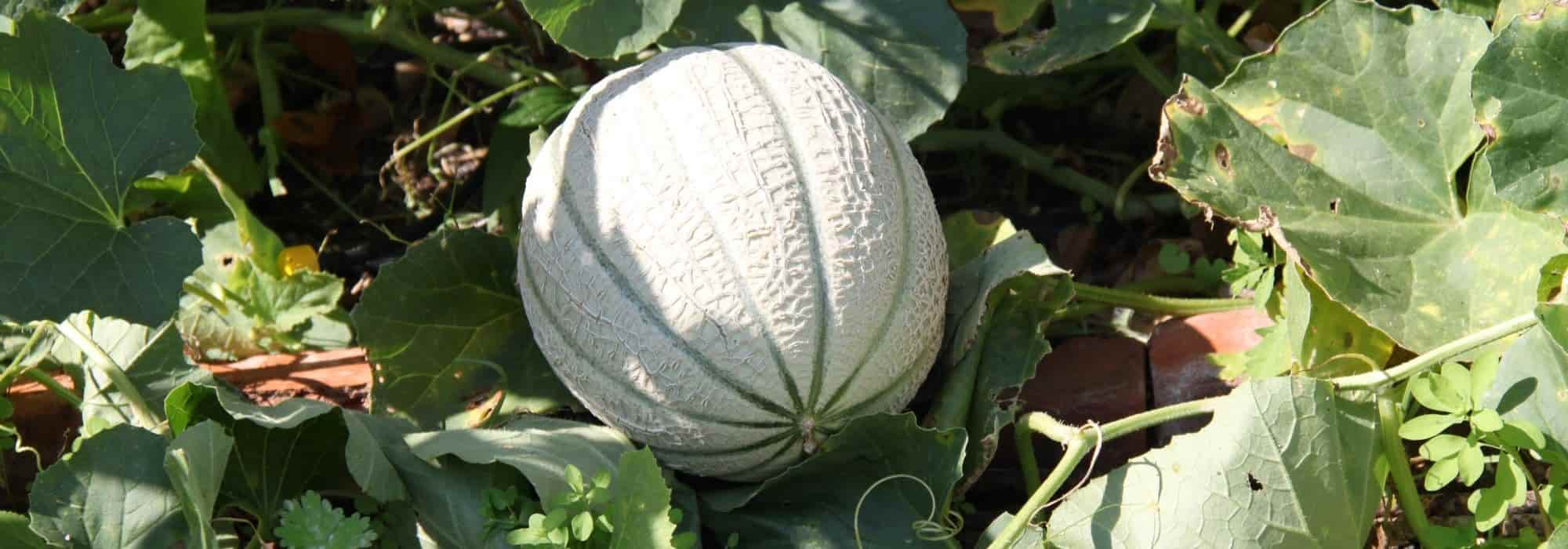
How to choose a melon?
Selection of melons based on their size, earliness, flavour, resistance, hardiness...
Contents
As soon as summer returns, melon (Cucumis melo) becomes a staple on tables. With its sweet and refreshing flesh, it is the king of summer meals. The pleasure of tasting it will be multiplied if this delicious melon has been grown in your garden. Indeed, it is possible to grow your own melons throughout France. Provided that a few essentials are respected. First, choose the variety best suited to your climate. Next, provide melon plants with soil rich in organic matter, light, and well-drained, along with optimal brightness and sunlight. Finally, water regularly and prune to encourage fruiting.
While market stalls and supermarkets tend to favour the uniformity of the Charentais melon, growing your own melons allows for a variety of types, whether they are heirloom, hybrid, or from elsewhere. Discover our selection of melons to choose from based on their size, flavour or texture, earliness, storage capacity, or resistance.
Before refining your choice, explore our full range of melons.
Depending on the size of the fruits
Some melons are renowned for their size and substantial weight. For instance, the ‘Mangomel’ melon, an astonishing hybrid variety whose skin changes from grey-green to yellow, indicating ripeness, produces large oval melons with mango aromas. The Canary Yellow 2 melon also offers beautifully sized fruits, weighing around 1.5 kg. Those of ‘Honey Dew’ are slightly smaller (about 1 kg) but provide a delicate fragrance.
Among Charentais melons, certain varieties are recognised for the size of their fruits. The ‘Chilton’, an American netted melon, is highly productive as its melons can reach 2 kg with fragrant, juicy flesh. ‘Rerato Degli Ortalani’, an Italian netted melon variety, also produces fruits weighing 2 kg with salmon-orange flesh. Similarly, Moscatello, another Italian cantaloupe variety, has fruits weighing between 2 and 3 kg. These fruits are highly aromatic, with a flavour reminiscent of muscat grapes.
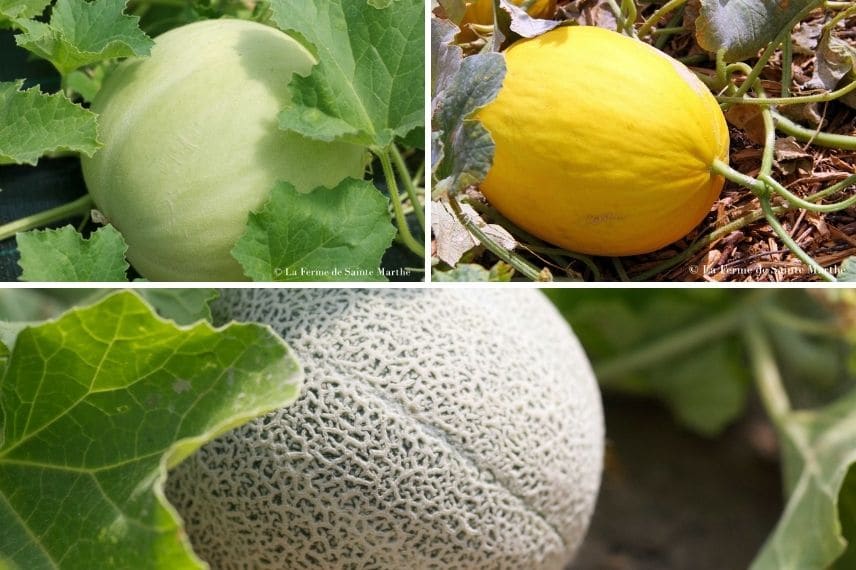
The melon varieties ‘Honey Dew’, ‘Canary Yellow’ and ‘Chilton’ are known for producing large fruits (©La Ferme de Sainte-Marthe)
Among Charentais melons, the ‘Troubadour’ stands out with fruits weighing 1 kg that do not split despite unfavourable climatic conditions. Similarly, ‘Artemis F1’ and ‘Stellio’.
Based on its colour
Obviously, when discussing the colour of a melon, orange comes to mind. This is particularly true for Charentais melons, which offer flesh that is more or less distinctly orange. ‘Troubadour’ and ‘Diabolo’ are among the Charentais melons with the most colourful flesh. As for ‘Orange Ananas’, it stands out even more. This sweet melon type features saffron flesh and a verrucate, bumpy epidermis, changing from dark green speckled with cream to yellow as it reaches ripeness.
Other melons may have flesh that is less colourful but just as tasty. For instance, the winter melon ‘Boule d’or’ has pale green to salmon pink flesh. The flesh of ‘Outdoor Wonder F1’, a sweet melon hybrid, and Galia is quite pale green.
The ‘Mango’ melon, an ancient Chinese variety, offers an astonishing white flesh with a slight tang.
Discover other Melon
View all →Available in 1 sizes
Available in 1 sizes
Available in 2 sizes
Available in 1 sizes
Available in 1 sizes
Available in 2 sizes
Available in 1 sizes
Available in 1 sizes
Available in 2 sizes
Available in 1 sizes
For the flavour and texture of their flesh
Overall, Charentais or cantaloupe melons are characterised by very sweet flesh and a fine, melting texture. The ‘Savor’ F1 Melons and ‘Diego’ F1 are excellent tasting varieties that never disappoint. Their flesh is sweet and highly fragrant. Out of category, the ‘Banana di Lentigione’ Melon truly stands out with its whitish, melting, sweet, and soft flesh. As for the ‘Délice de la table’, it lives up to its name: it boasts very sweet flesh that complements its extraordinary appearance resembling a small pumpkin.
However, if you are looking for melons with exceptional flavour, let yourself be tempted by the lovely American Pineapple with red flesh, a melon with green skin that produces sweet, fragrant, and juicy flesh. As for the ‘Sucrin de Tours’, it hardly hides its main asset, which is its sweetness. However, its flesh is firm.

The ‘American Pineapple with red flesh’ melon, the ‘Sucrin de Tours’, and the ‘Cavaillon espagnol’ melon (©La Ferme de Sainte-Marthe) benefit from exceptional flavour.
Those who prefer melons with firmer flesh will hardly be able to resist the originality of the ‘Cavaillon espagnol’ Melon. Its fruits are oval, firm, and sweet, with pink-orange flesh.
Read also
Succeeding in melon cultivationFor their hardiness
Rustic is a big word, but some melons prove to be more resistant to cold than others. They can therefore be grown north of the Loire. These are often old varieties, perfectly acclimatised to the regions from which they originate. Among these varieties that require less heat than others to bear fruit, the melon ‘Petit Gris de Rennes’ stands out as a prime example. It can be grown even if the summer is cool.

Cold-resistant melons, ‘Petit Gris de Rennes’ and ‘Noir des Carmes’ can be grown north of the Loire
The ‘Sucrin de Tours’ is an old variety that also adapts well to cooler summers, just like the ‘Noir de Carmes’, the Lunéville melon, or the ‘Ananas d’Amérique à chair rouge’.
For their long preservation
If you want to grow melons for long-term storage, forget about Charentais melons, as their melting, sweet flesh means they cannot be kept for more than 5 days without quality deterioration.
In contrast, winter melons store very well until the heart of winter in a cool room. Opt for the ‘Vert Olive d’Hiver’, an old and late variety with large oval fruits and pink flesh. The ‘Boule d’or’ has the advantage of being harvested until October and can be stored throughout the winter. The ‘Jaune Canari’ also keeps for many months in the cellar, just like ‘Honey Dew’.
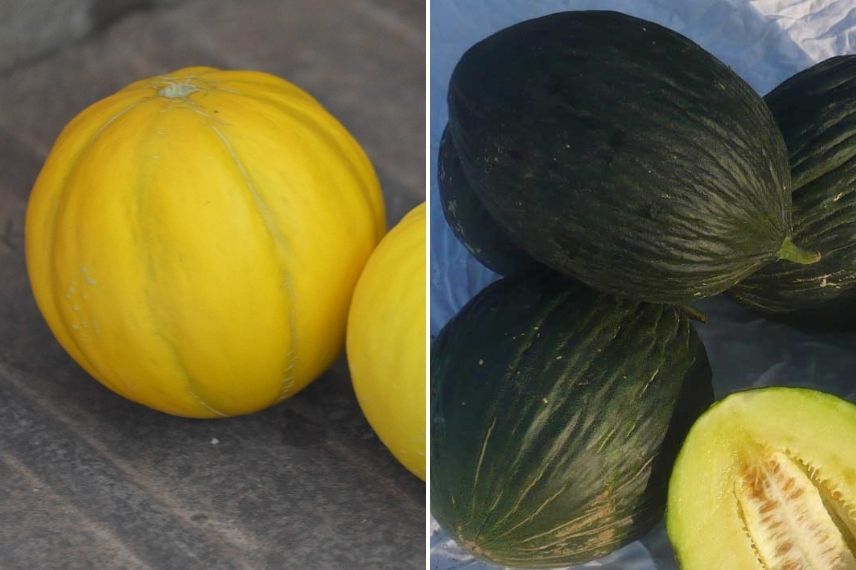
‘Boule d’or’ and ‘Vert Olive’ melons (©Ferme Sainte Marthe)
Based on their resistance to diseases
Melon is particularly sensitive to certain fungal diseases such as downy mildew and powdery mildew, as well as fusarium wilt. To prevent these diseases, certain conditions must be met, such as watering at the base, maintaining a sufficient planting distance, and regular hoeing and weeding. However, to maximise the chances of success, one can also choose varieties known for their disease resistance. These varieties are often hybrids that combine robustness with preserved flavour. The ‘Artémis’ F1 is a yellow Charentais melon that shows good resistance to powdery mildew, fusarium wilt, and aphids, which are often vectors of bacterial diseases. The melons ‘Anasta’ and ‘Diabolo’ are also very robust against diseases. As for the sweet melon ‘Outdoor Wonder’, it is capable of fighting against downy mildew.
In terms of their earliness or rapid growth
Why choosing a fast-growing or particularly early melon? Perhaps because one is an impatient gardener, but especially if living north of the Loire. This way, the harvest occurs more quickly, before the first autumn frosts that can compromise the ripeness of melons. For instance, the ‘Ancien Vieille France’ melon is an old variety that is easy to grow and fast-growing. Moreover, pruning is not obligatory for it to produce beautiful, tasty, and juicy fruits. The ‘Noir des Carmes’ melon is also an early variety that yields fruits with an astonishing black skin turning orange and thick, sweet flesh. It can be harvested as early as June.

The melons ‘Ancien Vieille France’ and ‘Climbing Green’ (©La Ferme de Sainte-Marthe) are known for their earliness or rapid growth
The ‘Climbing Green’ melon also stands out for its earliness, although its dark green, oblong fruits are also eye-catching. As its name suggests, it is ideal for training on a trellis.
Hybrid varieties of Charentais melons, such as ‘Cyrano’ and ‘Jérac’, can also be selected for their earliness. ‘Cyrano’ is particularly notable for its vigour, productivity, disease resistance, and taste quality. It is indeed a high-quality market garden melon.
- Subscribe!
- Contents
































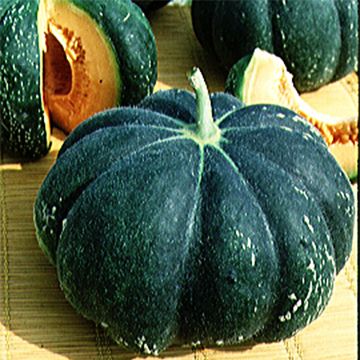


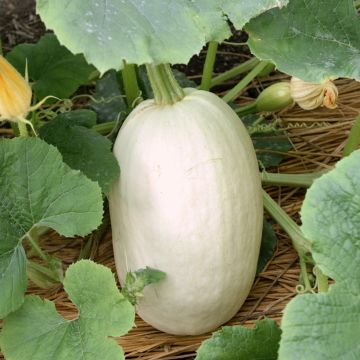



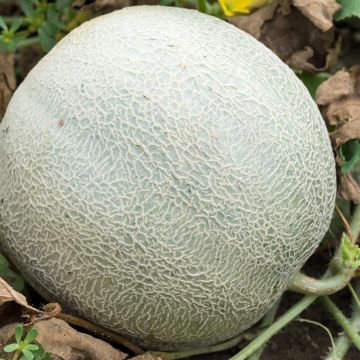

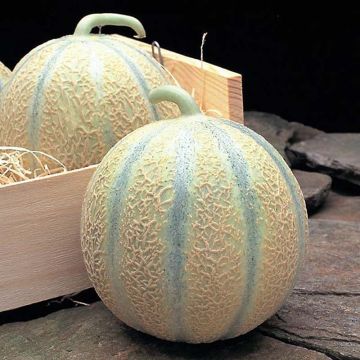
Comments